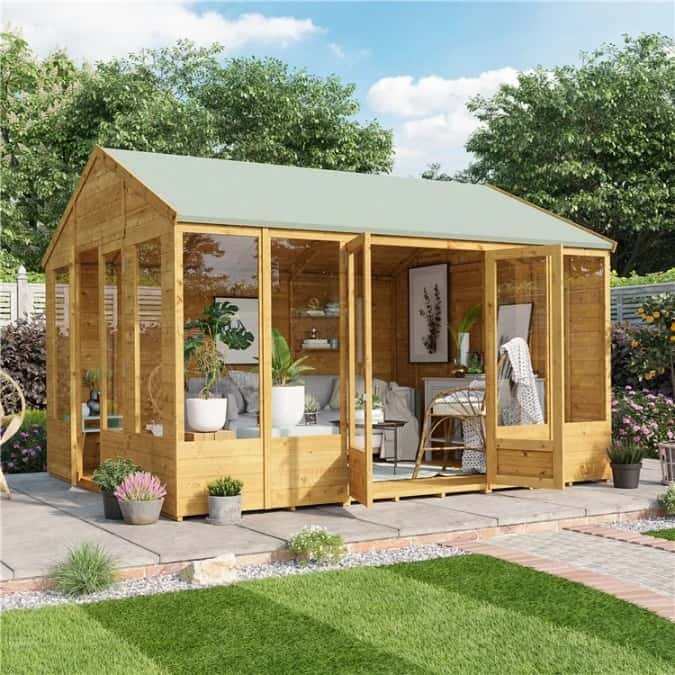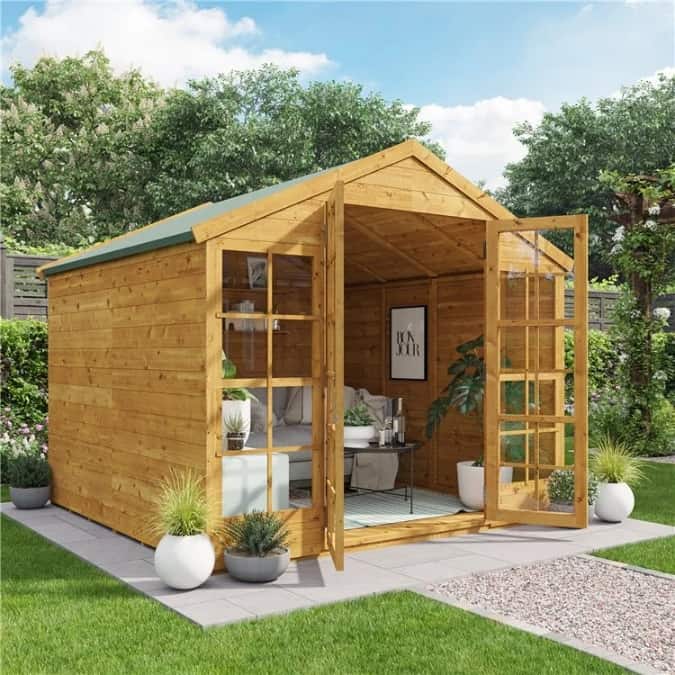Jump to:
There’s no better time to make the most of your garden than during the warmer months. Whether you’re looking at options for a garden summerhouse or you’re looking for another solution to stay cool on the hottest days, this guide is packed with tips to help you turn your garden into the ultimate spot to relax and unwind. Don’t miss out!
Find the Right Summer House For You

This one’s for you if you’re still on the hunt for the perfect summer house. We’ve rounded up the best types on the market to help you weigh up your options, including:
Contemporary
Most contemporary summer houses are a fresh twist on traditional log cabins. They’re all about sleek lines and a minimalistic look that fits into modern gardens. A contemporary summerhouse might be for you if you prefer something streamlined, like the BillyOh Dojo E unit.
Traditional
Then there’s the traditional type that brings back that classic charm. These summer houses feature architectural elements such as pitched roofs and decorative windows. They resemble quaint countryside cottages and are mostly built from wood. A fitting example is this BillyOh Petra Tongue and Groove Reverse Apex Summerhouse.
Corner
Corner summer houses are designed to fit snugly into the corners of outdoor spaces. Their triangular or trapezoidal shape makes up for their space-saving qualities. If you have an unused corner in your garden, BillyOh Picton can fill it and make it more functional this golden season!
Log cabin summer houses
The design mixes a summer house and a log cabin, hence the name. If you’re stuck between choosing a log cabin or a summerhouse, this one’s the perfect middle ground. For reference, check out the BillyOh Darcy unit. It offers the durability of a log cabin and the relaxed vibe of a summerhouse. Summerhouses with a log cabin build have thicker walls than their panelled counterparts, so they are better insulated against both heat and cold.
Summer house sheds
Think a log cabin summerhouse might not cut it? Well, why not have both – with the added convenience of a side storage shed to top it off? Cue summer house sheds. The BillyOh Tianna offers all that and more! It’s the ultimate combo of relaxation and storage in one structure and a great value for your money.
Decorate the Summerhouse
Once you’ve chosen a summerhouse that suits your style, or if your existing one is ready for a bit of makeover, it’s time to decorate the space and make it feel cosy and homey.
A tropical or beach-inspired interior, for instance, is a great way to embrace the summer vibe. Think of shades of blue, green, beige, and white in your paint, decor, accessories, and more. Natural materials for garden furniture, such as rattan, bamboo, and wicker, can tie the look together.
Or, why not make the most of your backyard pool by transforming your summerhouse into a pool house? Add a comfy couch for relaxing and storage for pool essentials like floats. A sun lounger or hammock will extend the space and create the perfect spot to unwind after a swim.
You can’t go wrong with a sunroom-inspired retreat – perfect for soaking up all that sunlight! This works especially well if your summerhouse has floor-to-ceiling windows and is positioned in a spot that gets plenty of sun throughout the day.
The potential is endless! For more ideas, have a read of ‘Summer House Interior Ideas You Don’t Wanna Miss!’
You Can’t Beat Good Ventilation in the Summer Heat

In short, ventilate your summer house! No matter how inviting the interior is, if there’s no good airflow, it can become stuffy and uncomfortable. And with the warmer weather, that’s the last thing you want, so make sure fresh air is flowing in.
The best way to do this? Take advantage of those big windows, doors, or skylights (if your summerhouse has them) and open them! This allows for cross ventilation, where cool air enters through one opening while warm air exits through another.
If you have the budget, you can also consider these options:
Wall vents
Wall vents are a must for good airflow in wooden garden buildings. These vents have small openings or grills and are usually covered with a mesh to keep insects out. They let air flow in and out, helping to keep the space well-ventilated. It’s best to install them near the top and bottom of the walls—higher up for warm air to escape and lower down for cooler air to enter.
Ridge vents
Alternatively, go for ridge vents, which are long, narrow vents placed along the roof’s peak, where two sides of the roof meet. These vents let hot air escape from the highest point of the summerhouse. This helps keep the inside cooler and more comfortable, even on the hottest days, making it much nicer to spend time inside.
Turbines
Turbines are round, rotating vents that look like small, spinning domes that catch the wind to help circulate air. As the wind turns the turbine, it helps draw hot air out of your summerhouse. Louvred turbines, for one, are a great choice. Their adjustable slats let you control the airflow and manage the temperature inside.
Ceiling fans
Ceiling fans are an effective way to ventilate a room while saving energy. Once turned on, they circulate the air and create a draft throughout the room. They don’t use as much power as cranking up the AC on a hot day. Portable pedestal fans and wall-mounted ones are great alternatives, too.
Since ceiling fans are electric, you’ll need to install electricity in your shed to use one. If you’re considering this, this guide can help: Top 5 Questions to Consider Before Installing Garden Building Electricity
Shade and Sun Protection Make a Difference
Sometimes, ventilation alone isn’t enough, and you’ll need a backup solution. That’s where garden shades come in—and there are plenty of options to choose from. But before we head straight into the list, here’s why shading is worth considering:
- It stops sunlight from overheating the space.
- It protects you and your furniture from harmful UV rays.
- By cutting down on heat, you won’t need to rely as much on cooling systems, which could save energy and reduce costs.
See how a bit of shade can make all the difference?
Awnings, canopies, or blinds
These are great for keeping the sun out and controlling how much light gets in. Here are a few ideas to try:
- Retractable awnings: These give you the flexibility to extend or roll them back as needed, so you can adjust the shade throughout the day.
- Canopies: Perfect for overhead shade, and they come in loads of styles and materials to suit your summerhouse.
- Blinds or shades: Fit these to your windows and doors to block out harsh sunlight.
Shade-providing trees and pergolas
- Shade trees: Plant trees in just the right spots around your garden and let nature do the work! Look for ones with a dense canopy that suits your garden and local climate. They’ll add natural shade and look fantastic. Need ideas? Check out our ‘Guide to the UK’s Fastest Growing Trees’.
- Pergolas: A pergola is a simple structure with vertical posts and horizontal beams, often with a slatted or open roof. It lets sunlight filter through while offering partial shade. You can attach one side to your summerhouse wall to create an extended, shaded space that’s perfect for al fresco meals. Bistro dining sets would look great in this setup, too!
Round-up
You can’t beat good ventilation in the summer heat when it comes to keeping your summerhouse cool on hot days. Take advantage of those big windows, doors, or skylights and open them up! Vents and fans also help maintain good airflow inside. If these methods aren’t enough, garden shades are always a solid backup solution.
With these ideas, along with some buying tips if you’re planning to invest in one soon, you can beat the heat and create a refreshing retreat in your own backyard!
Up next on your reading list: How to Keep Flies Out My Summer House










